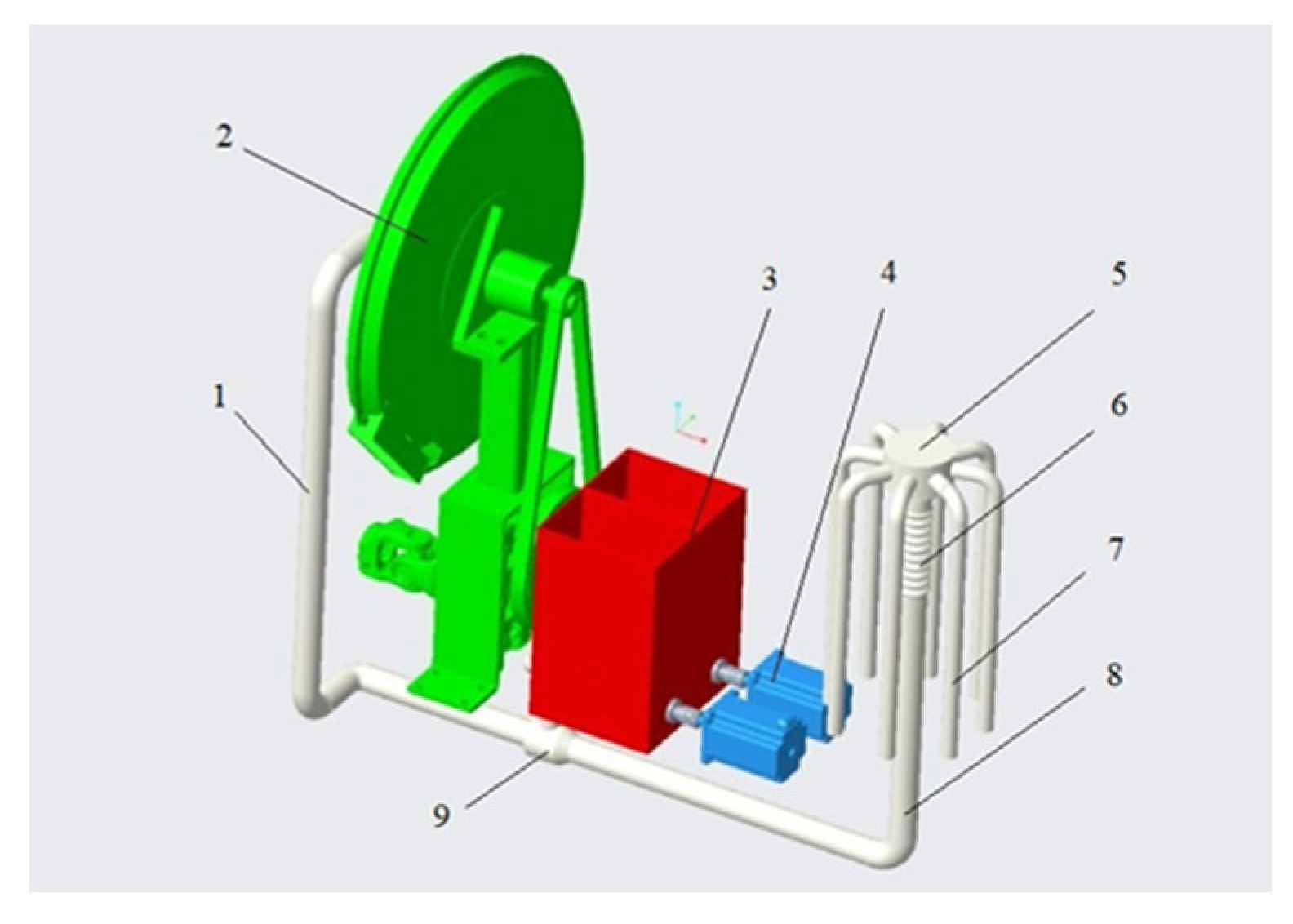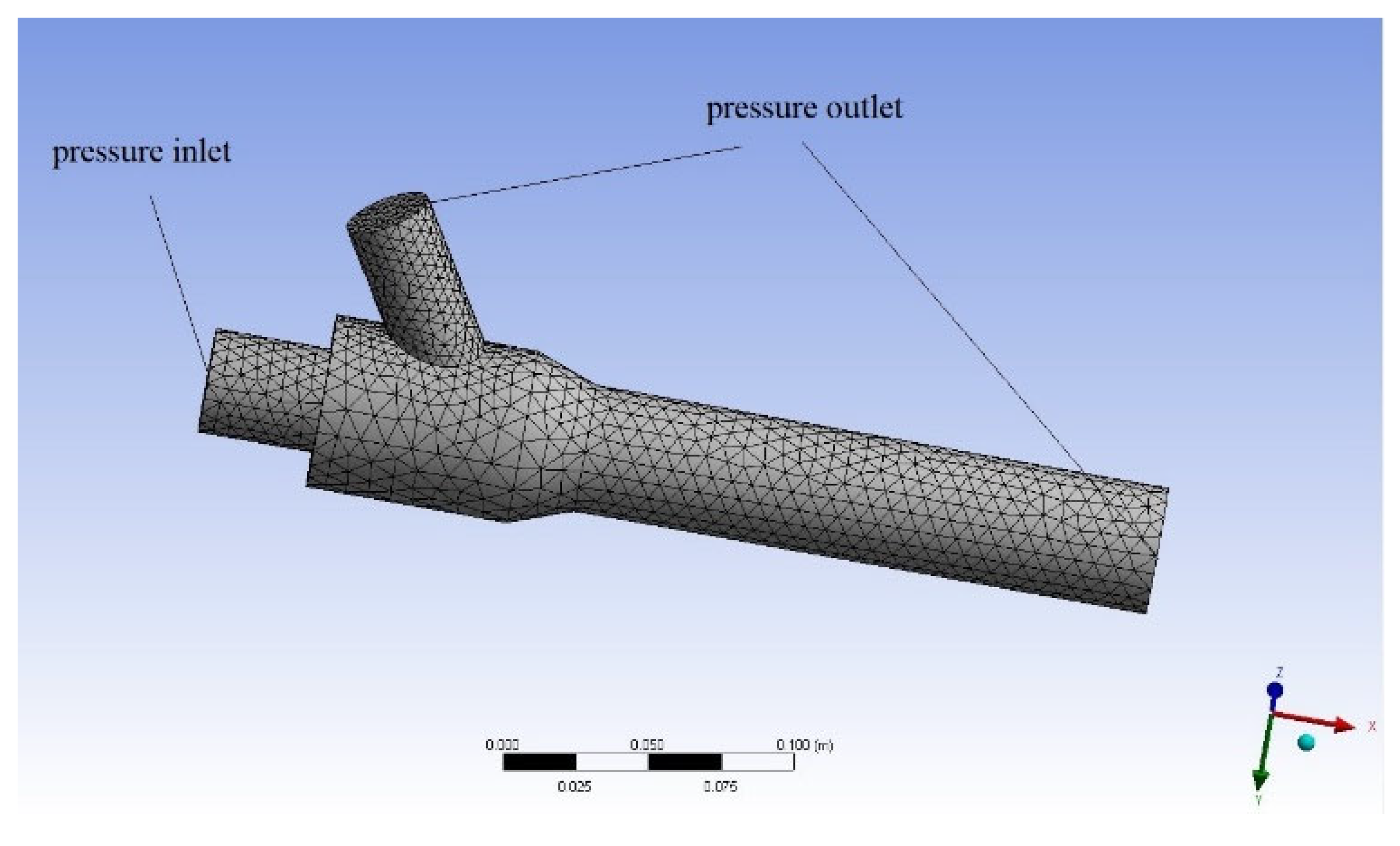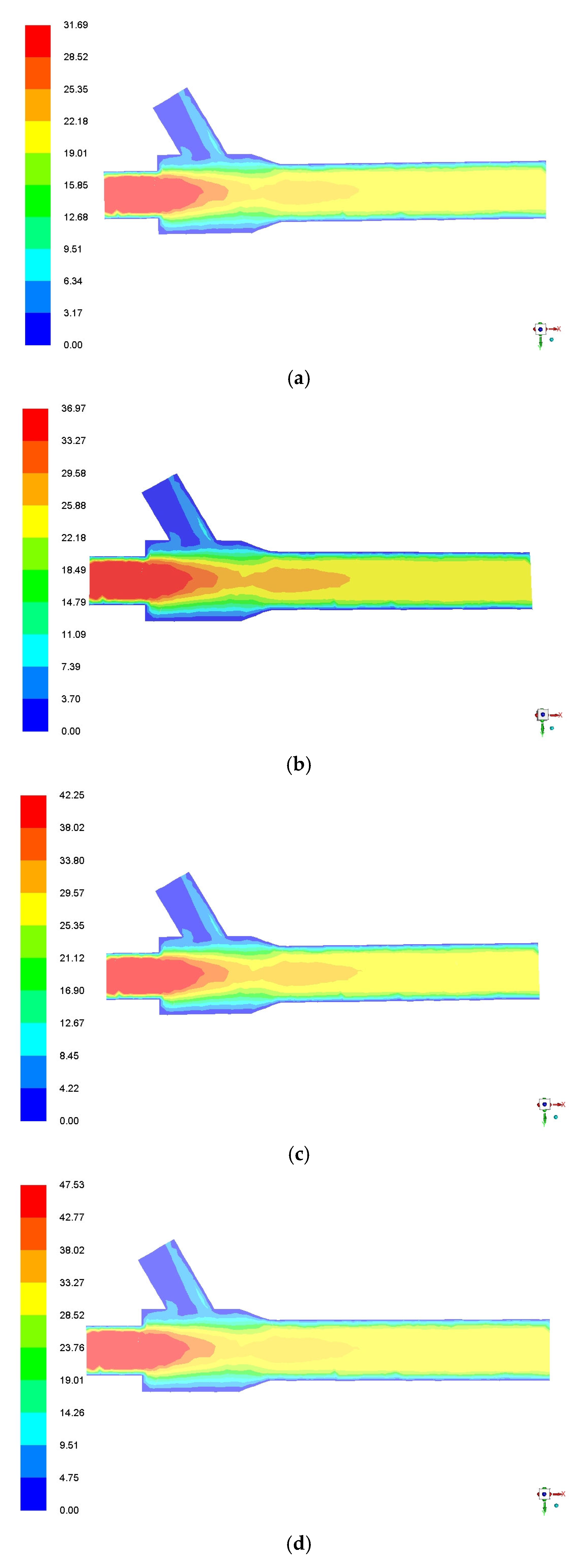Mixed Seeds of Oat and Vetch Based on DEM-Fluent Coupling Motion Simulation in a Venturi Tube
Abstract
1. Introduction
2. Structure and Working Principle of Air-Blowing Seed-Metering Device
3. Basic Parameters and Model Establishment of Seed Delivery Device
3.1. Basic Parameters of Venturi Seed Delivery Device
3.1.1. Air Inlet Velocity
3.1.2. Seed Gas Delivery Ratio
3.1.3. Air Inlet Pipe Diameter
3.2. Establishment of Gas–Solid Two-Phase Flow Model
3.3. DEM-CFD Coupling Simulation Method
3.3.1. Solid Model
3.3.2. Airflow Phase Model
3.3.3. Seed-Feeding Process Simulation
4. Results and Discussion
4.1. Effect of Seeding Angle on the Flow Field in the Tube
4.2. Effect of Seed Insertion Angle on Seed Movement in Tube
4.3. Influence of Inlet Air Velocity on Airflow Field
4.4. Effect of Inlet Air Velocity on Seed Movement in Tube
4.5. Test Verification
5. Conclusions
- (1)
- The flow characteristics of gas–solid two-phase flow in the venturi tube and the force acting on the mixed seeds were analyzed. The mixed seeds of oat and vetch slowly entered the mixing zone from the seed tube to form gas–solid two-phase flow. Due to the large air velocity in the mixing zone, the seeds accelerated in the mixing zone to the transition zone and the transport zone under the drag force of the airflow. In the tube, there was a relative movement between the airflow and the seed, and the airflow speed was greater than the seed movement speed. It is shown that the drag force generated by the airflow on the seed promotes the seed movement.
- (2)
- Different seeding angles have great influence on the variation of airflow field in the tube and the motion characteristics of mixed seeds. With the increase in seeding angle, the air velocity in the mixing zone first increases and then decreases, and the change in velocity gradient along the x-axis direction is prolonged. The increase in seed entry angle leads to the reduction in friction between the seeds and the pipe wall. The shorter the distance before the seeds contact the pipe wall, the more seeds will be blown forward. After the seeds collide with the pipe wall, some seeds will remain in the mixing zone and transition zone and cannot be transported forward. When the angle of entry and exit is 60°, the pressure and velocity of the airflow field change obviously and the range is reasonable, the airflow field is relatively uniform, the speed change of the seeds is consistent, there is no seed retention phenomenon, and the seeds are continuously and evenly blown out.
- (3)
- The inlet air velocity has a significant influence on the air velocity in the tube, the moving velocity of the mixed seeds, and the force acting on the mixed seeds. The greater the inlet air velocity is, the greater the air velocity in the pipe is, while the pressure and velocity of the airflow field are basically the same. With the increase in inlet air velocity, the resultant force on the seeds and the movement speed of the seeds are larger, the collision position between the mixed seeds and the wall is closer to the outlet pipe, and the spacing between the seeds is larger. When the inlet air velocity is too high, the speed of the seeds varies greatly, and the spacing between some seeds is too large or too small, resulting in discontinuous and uneven seed movement. The appropriate air velocity is 35~40 m/s, and the mixed seeds of oat and vetch can continuously and uniformly enter the venturi mixing area and conveying area with a mass ratio of 1:1 and be blow out in order.
Author Contributions
Funding
Data Availability Statement
Acknowledgments
Conflicts of Interest
References
- Zhao, C.Z.; Zhang, J.; Sheng, Y.P. The niche of annual mixed-seeding meadow in response to density in alpine region of the Qilian Mountain, China. Shengtai Xuebao Acta Ecol. Sin. 2013, 33, 5266–5273. [Google Scholar] [CrossRef]
- Sturlu Dottir, E.; Brophy, C.; Belanger, G.; Gustavsson, A.M.; Jorgensen, M.; Lunnan, T.; Helgadottir, A. Benefits of mixing grasses and legumes for herbage yield and nutritive value in Northern Europe and Canada. Grass Forage Sci. J. Br. Grassl. Soc. 2014, 69, 22940. [Google Scholar] [CrossRef]
- Lu, Y.X.; Mu, L.; Yang, H.M. Research progress of mixed planting of leguminous and gramineous forages to improve soil. Trans. Chin. J. Grassl. 2019, 41, 94–100. [Google Scholar]
- Zhu, Y.Q.; Yu, H.; Zheng, W.; Li, S.S.; Naerkezi; Liu, Y.H.; Hao, S.; Ailifeire. Effects of different planting configurations on yield of Avena sativa and Vicia sativa mixed plantings with soybean in alpine pastures. Acta Prataculturae Sin. 2020, 29, 74–85. [Google Scholar]
- Qi, Y.S.; Zhu, L.; Xu, X. Mixed Sowing Combination of Grass, Bean and Forage in Ningxia Oasis and Its Proportional Effect. Trans. Grass Ind. Sci. 2015, 32, 1463–1472. [Google Scholar]
- Yang, L.; Yan, B.X.; Cui, T.; Yu, Y.M.; He, X.T.; Liu, Q.W.; Liang, Z.J.; Yin, X.W.; Zhang, D.X. Global overview of research progress and development of precision maize planters. Int. J. Agric. Biol. Eng. 2016, 9, 9–26. [Google Scholar] [CrossRef]
- Yin, W.Q.; Zhao, L.; Li, H.; Hu, F.; Yu, H.M. Design and experiment on suction nozzle type hole of pneumatic-sheave combined vegetable precision metering device. Trans. Chin. Soc. Agric. Mach. 2019, 50, 68–76. [Google Scholar] [CrossRef]
- Li, Y.J.; Liu, R.; Liu, C.X.; Liu, L.J. Test of seed velocity of seed tube based on EDEM-Fluent coupling. Trans. Chin. Soc. Agric. Mach. 2021, 52, 54–61. [Google Scholar]
- Ji, Y.; Liu, S.; Li, J. Experimental and numerical studies on dense-phase pneumatic conveying of spraying material in venturi. Powder Technol. 2018, 339, 419–433. [Google Scholar] [CrossRef]
- Gao, X.J.; Xu, Y.; Yang, L.; Zhang, D.X.; Li, Y.H.; Cui, T. Simulation and experiment of uniformity of venturi feeding tube based on DEM-CFD coupling. Trans. Chin. Soc. Agric. Mach. 2018, 49, 92–100. [Google Scholar]
- Yang, Q.L.; Li, Z.H.; Li, H.W.; He, J.; Wang, Q.J.; Lu, C.Y. Numerical analysis of particle motion in pneumatic centralized fertilizer distribution device based on CFD-DEM. Trans. Chin. Soc. Agric. Mach. 2019, 50, 81–89. [Google Scholar] [CrossRef]
- Mori, Y.; Sakai, M. Development of a robust Eulerian—Lagrangian model for the simulation of an industrial solid–fluid system. Chem. Eng. J. 2021, 406, 126841. [Google Scholar] [CrossRef]
- Patro, P.; Dash, S.K. Two-fluid modeling of turbulent particle–gas suspensions in vertical pipes. Powder Technol. 2014, 264, 320–331. [Google Scholar] [CrossRef]
- Lei, X.L.; Liao, Y.T.; Liao, Q.X. Simulation of seed motion in seed feeding device with DEM-CFD coupling approach for rapeseed and wheat. Comput. Electron. Agric. 2016, 131, 29–39. [Google Scholar] [CrossRef]
- Guzman, L.; Chen, Y.; Landry, H. Coupled CFD-DEM Simulation of Seed Flow in an Air Seeder Distributor Tube. Processes 2020, 8, 1597. [Google Scholar] [CrossRef]
- Wang, Y.; Li, H.; Hu, H.; He, J.; Wang, Q.; Lu, C.; Liu, P.; He, D.; Lin, X. DEM—CFD coupling simulation and optimization of a self-suction wheat shooting device. Powder Technol. 2021, 393, 494–509. [Google Scholar] [CrossRef]
- Han, D.D.; Zhang, D.X.; Jing, H.R.; Yang, L.; Cui, T.; Ding, Y.Q.; Wang, Z.D.; Wang, Y.X.; Zhang, T.L. DEM-CFD coupling simulation and optimization of an inside-filling air-blowing maize precision seed-metering device. Comput. Electron. Agric. 2018, 150, 426–438. [Google Scholar] [CrossRef]
- Hu, H.; Zhou, Z.; Wu, W.; Yang, W.; Li, T.; Chang, C.; Ren, W.; Lei, X. Distribution characteristics and parameter optimisation of an air-assisted centralised seed-metering device for rapeseed using a CFD-DEM coupled simulation. Biosyst. Eng. 2021, 208, 246–259. [Google Scholar] [CrossRef]
- Gao, X.; Zhou, Z.; Xu, Y.; Yu, Y.; Su, Y.; Cui, T. Numerical simulation of particle motion characteristics in quantitative seed feeding system. Powder Technol. 2020, 367, 643–658. [Google Scholar] [CrossRef]
- Lei, X.; Liao, Y.; Zhang, Q.; Wang, L.; Liao, Q. Numerical simulation of seed motion characteristics of distribution head for rapeseed and wheat. Comput. Electron. Agric. 2018, 150, 98–109. [Google Scholar] [CrossRef]
- Kruggel-Emden, H.; Oschmann, T. Numerical study of rope formation and dispersion of non-spherical particles during pneumatic conveying in a pipe bend. Powder Technol. 2014, 268, 219–236. [Google Scholar] [CrossRef]
- Fengwei, G.; Youqun, Z.; Feng, W.; Zhichao, H.; Lili, S. Simulation analysis and experimental validation of conveying device in uniform rrushed straw throwing and seed-sowing Machines using CFD-DEM coupled approach. Comput. Electron. Agric. 2022, 193, 106720. [Google Scholar] [CrossRef]
- Xu, J.; Liu, X.; Pang, M. Numerical and experimental studies on transport properties of powder ejector based on double venturi effect. Vacuum 2016, 134, 92–98. [Google Scholar] [CrossRef]
- Chang, J.L.; Zhang, X.H. Design and test of one-step centralized type pneumatic seeding system. Trans. CSAE 2011, 27, 136–141. [Google Scholar]
- Sommerfeld, M. Analysis of collision effects for turbulent gas-particle flow in a horizontal channel: Part I. Particle transport. Int. J. Multiph. Flow 2003, 29, 675–699. [Google Scholar] [CrossRef]
- Liao, Y.Y.; You, Y.; Wang, D.C.; Zhang, X.N.; Zhang, H.F.; Ma, W.P. Parameter Calibration and Experiment of Discrete Element Model for Mixed Seeds of Oat and Arrow Pea. Trans. Chin. Soc. Agric. Mach. 2022, 53, 14–22. [Google Scholar]












| Material | Parameters | Value |
|---|---|---|
| ABS plastic | Poisson’s ratio | 0.34 |
| Shear modulus (Pa) | 3 × 109 | |
| Density (kg·m−3) | 1250 | |
| Oat seeds | Geometric dimension (mm × mm × mm) | 10.977 × 3.253 × 2.437 |
| Poisson’s ratio | 0.40 | |
| Shear modulus (Pa) | 1.1 × 108 | |
| Density (kg·m−3) | 802 | |
| Collision recovery coefficient with ABS plastic | 0.441 | |
| Static friction coefficient with ABS plastic | 0.506 | |
| Rolling friction coefficient with ABS plastic | 0.059 | |
| Vetch seeds | Geometric dimension (mm × mm × mm) | 5.506 × 4.794 × 3.594 |
| Poisson’s ratio | 0.25 | |
| Shear modulus (Pa) | 2.7 × 108 | |
| Density (kg·m−3) | 1076.5 | |
| Collision recovery coefficient with ABS plastic | 0.435 | |
| Static friction coefficient with ABS plastic | 0.454 | |
| Rolling friction coefficient with ABS plastic | 0.047 | |
| Mixed seeds | Interspecific collision recovery coefficient | 0.320 |
| Interspecific static friction coefficient | 0.327 | |
| Interspecies rolling friction coefficient | 0.042 |
| Feeding Tube Angle (°) | v | F | The Number of Collisions n | ||||
|---|---|---|---|---|---|---|---|
| 30 | 0.55 | 0.45 | 0.16 | 54.50 | 27.34 | 1.43 × 10−3 | 5 |
| 45 | 0.83 | 0.67 | 0.25 | 73.93 | 41.89 | 1.62 × 10−3 | 3 |
| 60 | 0.92 | 0.70 | 0.30 | 82.00 | 49.83 | 1.54 × 10−3 | 6 |
| 75 | 0.88 | 0.60 | 0.31 | 73.66 | 48.97 | 1.58 × 10−3 | 29 |
| 90 | 0.60 | 0.33 | 0.29 | 43.66 | 24.16 | 2.11 × 10−3 | 59 |
| Air Velocity (m/s) | V (m/s) | (m/s) | (m/s) | (rad/s) | (rad/s) | F (N) |
|---|---|---|---|---|---|---|
| 30 | 1.26 | 1.06 | 0.35 | 101.21 | 53.53 | 1.68 × 10−3 |
| 35 | 1.43 | 1.25 | 0.37 | 107.82 | 71.46 | 1.84 × 10−3 |
| 40 | 1.55 | 1.34 | 0.39 | 100.61 | 68.57 | 1.97 × 10−3 |
| 45 | 1.64 | 1.40 | 0.41 | 93.84 | 62.81 | 2.15 × 10−3 |
| 50 | 1.72 | 1.47 | 0.43 | 86.84 | 51.60 | 2.45 × 10−3 |
Disclaimer/Publisher’s Note: The statements, opinions and data contained in all publications are solely those of the individual author(s) and contributor(s) and not of MDPI and/or the editor(s). MDPI and/or the editor(s) disclaim responsibility for any injury to people or property resulting from any ideas, methods, instructions or products referred to in the content. |
© 2023 by the authors. Licensee MDPI, Basel, Switzerland. This article is an open access article distributed under the terms and conditions of the Creative Commons Attribution (CC BY) license (https://creativecommons.org/licenses/by/4.0/).
Share and Cite
Liao, Y.; You, Y.; Hui, Y.; Zhang, X.; Wang, D. Mixed Seeds of Oat and Vetch Based on DEM-Fluent Coupling Motion Simulation in a Venturi Tube. Processes 2023, 11, 1095. https://doi.org/10.3390/pr11041095
Liao Y, You Y, Hui Y, Zhang X, Wang D. Mixed Seeds of Oat and Vetch Based on DEM-Fluent Coupling Motion Simulation in a Venturi Tube. Processes. 2023; 11(4):1095. https://doi.org/10.3390/pr11041095
Chicago/Turabian StyleLiao, Yangyang, Yong You, Yunting Hui, Xuening Zhang, and Decheng Wang. 2023. "Mixed Seeds of Oat and Vetch Based on DEM-Fluent Coupling Motion Simulation in a Venturi Tube" Processes 11, no. 4: 1095. https://doi.org/10.3390/pr11041095
APA StyleLiao, Y., You, Y., Hui, Y., Zhang, X., & Wang, D. (2023). Mixed Seeds of Oat and Vetch Based on DEM-Fluent Coupling Motion Simulation in a Venturi Tube. Processes, 11(4), 1095. https://doi.org/10.3390/pr11041095







